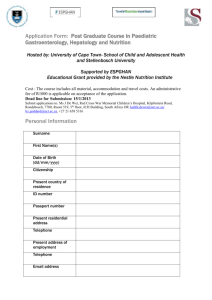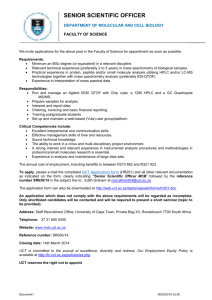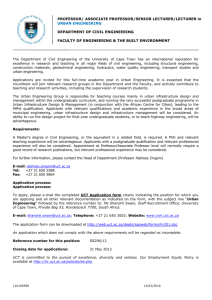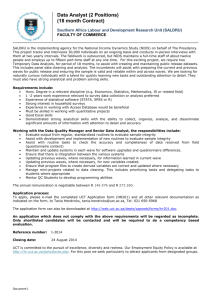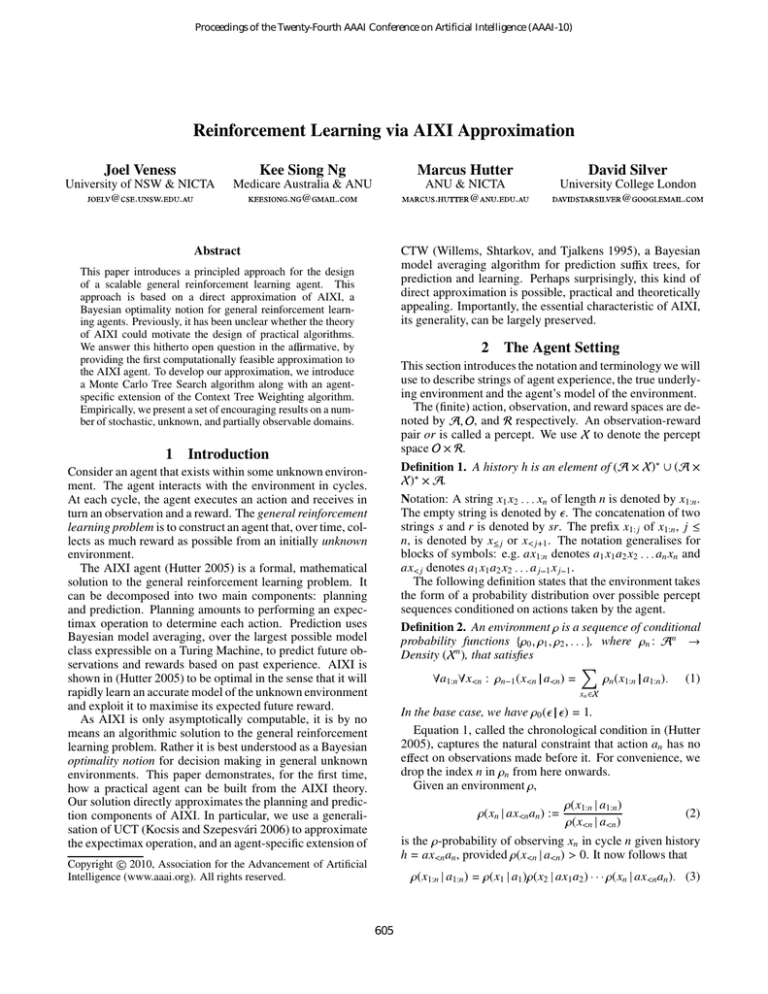
Proceedings of the Twenty-Fourth AAAI Conference on Artificial Intelligence (AAAI-10)
Reinforcement Learning via AIXI Approximation
Joel Veness
Kee Siong Ng
Marcus Hutter
David Silver
University of NSW & NICTA
Medicare Australia & ANU
ANU & NICTA
University College London
@
.
.
.
. @
.
.
Abstract
@
.
.
@
.
CTW (Willems, Shtarkov, and Tjalkens 1995), a Bayesian
model averaging algorithm for prediction su x trees, for
prediction and learning. Perhaps surprisingly, this kind of
direct approximation is possible, practical and theoretically
appealing. Importantly, the essential characteristic of AIXI,
its generality, can be largely preserved.
This paper introduces a principled approach for the design
of a scalable general reinforcement learning agent. This
approach is based on a direct approximation of AIXI, a
Bayesian optimality notion for general reinforcement learning agents. Previously, it has been unclear whether the theory
of AIXI could motivate the design of practical algorithms.
We answer this hitherto open question in the a rmative, by
providing the first computationally feasible approximation to
the AIXI agent. To develop our approximation, we introduce
a Monte Carlo Tree Search algorithm along with an agentspecific extension of the Context Tree Weighting algorithm.
Empirically, we present a set of encouraging results on a number of stochastic, unknown, and partially observable domains.
2 The Agent Setting
This section introduces the notation and terminology we will
use to describe strings of agent experience, the true underlying environment and the agent’s model of the environment.
The (finite) action, observation, and reward spaces are de, and respectively. An observation-reward
noted by
pair or is called a percept. We use to denote the percept
space
.
) (
Definition 1. A history h is an element of (
)
.
Notation: A string x1 x2
xn of length n is denoted by x1:n .
The empty string is denoted by . The concatenation of two
strings s and r is denoted by sr. The prefix x1: j of x1:n , j
n, is denoted by x j or x j 1 . The notation generalises for
blocks of symbols: e.g. ax1:n denotes a1 x1 a2 x2 an xn and
ax j denotes a1 x1 a2 x2 a j 1 x j 1 .
The following definition states that the environment takes
the form of a probability distribution over possible percept
sequences conditioned on actions taken by the agent.
Definition 2. An environment is a sequence of conditional
probability functions 0 1 2
, where n : n
n
Density ( ), that satisfies
1 Introduction
Consider an agent that exists within some unknown environment. The agent interacts with the environment in cycles.
At each cycle, the agent executes an action and receives in
turn an observation and a reward. The general reinforcement
learning problem is to construct an agent that, over time, collects as much reward as possible from an initially unknown
environment.
The AIXI agent (Hutter 2005) is a formal, mathematical
solution to the general reinforcement learning problem. It
can be decomposed into two main components: planning
and prediction. Planning amounts to performing an expectimax operation to determine each action. Prediction uses
Bayesian model averaging, over the largest possible model
class expressible on a Turing Machine, to predict future observations and rewards based on past experience. AIXI is
shown in (Hutter 2005) to be optimal in the sense that it will
rapidly learn an accurate model of the unknown environment
and exploit it to maximise its expected future reward.
As AIXI is only asymptotically computable, it is by no
means an algorithmic solution to the general reinforcement
learning problem. Rather it is best understood as a Bayesian
optimality notion for decision making in general unknown
environments. This paper demonstrates, for the first time,
how a practical agent can be built from the AIXI theory.
Our solution directly approximates the planning and prediction components of AIXI. In particular, we use a generalisation of UCT (Kocsis and Szepesvári 2006) to approximate
the expectimax operation, and an agent-specific extension of
a1:n x
n
:
n 1 (x n
a n)
n (x1:n
a1:n )
(1)
xn
In the base case, we have 0 ( ) 1.
Equation 1, called the chronological condition in (Hutter
2005), captures the natural constraint that action an has no
e ect on observations made before it. For convenience, we
drop the index n in n from here onwards.
Given an environment ,
(xn ax n an ) :
(x1:n a1:n )
(x n a n )
(2)
is the -probability of observing xn in cycle n given history
h ax n an , provided (x n a n ) 0. It now follows that
Copyright 2010, Association for the Advancement of Artificial
Intelligence (www.aaai.org). All rights reserved.
(x1:n a1:n )
605
(x1 a1 ) (x2 ax1 a2 )
(xn ax n an )
(3)
Definition 4. Given a model class
:
1 2
and a prior weight w0
0 for each
such
that
w0
1, the mixture environment model is
(x1:n a1:n ) :
w0 (x1:n a1:n ).
Definition 2 is used to describe both the true (but unknown) underlying environment and the agent’s subjective
model of the environment. The latter is called the agent’s
environment model and is typically learnt from data. Definition 2 is extremely general. It captures a wide variety of
environments, including standard reinforcement learning setups such as MDPs and POMDPs.
The agent’s goal is to accumulate as much reward as it can
during its lifetime. More precisely, the agent seeks a policy
that will allow it to maximise its expected future reward up
to a fixed, finite, but arbitrarily large horizon m
. Formally, a policy is a function that maps a history to an action.
The expected future value of an agent acting under a particular policy is defined as follows.
Definition 3. Given history ax1:t , the m-horizon expected
future reward of an agent acting under policy : (
)
with respect to an environment is
The next result follows immediately.
Proposition 1. A mixture environment model is an environment model.
Proposition 1 allows us to use a mixture environment
model whenever we can use an environment model. Its importance will become clear shortly.
To make predictions using a mixture environment model
, we use
(x1:n a1:n )
(xn ax n an )
(7)
(x n a n )
which follows from Proposition 1 and Eq. 2. The RHS of
Eq. 7 can be written out as a convex combination of model
predictions to give
t m
vm ( ax1:t ) :
xt
Ri (ax
1:t m
(4)
t m)
(xn ax n an )
i t 1
where for t 1 k t m, ak : (ax k ), and Rk (aor t m ) :
rk . The quantity vm ( ax1:t at 1 ) is defined similarly, except
that at 1 is now no longer defined by .
is the policy that maximises the
The optimal policy
expected future reward. The maximal achievable expected
future reward of an agent with history h in environment
looking m steps ahead is V m (h) : vm ( h). It is easy to see
that if h ax1:t (
)t , then
where the posterior weight wn
wn
max
at 1
xt 1
(xt
1
hat 1 )
(xt
max
at m
m
haxt
1:t m 1 at m )
xt m
ri
(5)
i t 1
We will refer to Equation 5 as the expectimax operation.
The m-horizon optimal action at 1 at time t 1 is related to
the expectimax operation by
at
1
arg max V m (ax1:t at 1 )
at
(6)
1
Eqs 4 and 5 can be modified to handle discounted reward,
however we focus on the finite-horizon case since it both
aligns with AIXI and allows for a simplified presentation.
3
:
w0 (x
(xn ax n an )
n
w0 (x
1
for
is given by
a n)
n
a n)
Pr(
ax n)
(8)
(9)
Bayesian agents enjoy a number of strong theoretical performance guarantees; these are explored in Section 6. In
practice, the main di culty in using a mixture environment
model is computational. A rich model class is required if the
mixture environment model is to possess general prediction
capabilities, however naively using (8) for online prediction
requires at least O( ) time to process each new piece of
experience. One of our main contributions, introduced in
Section 5, is a large, e ciently computable mixture envi)). Before
ronment model that runs in time O(log(log
looking at that, we will examine in the next section a Monte
Carlo Tree Search algorithm for approximating the expectimax operation.
t m
V m (h)
1
1
wn
4 Monte Carlo Expectimax Approximation
Bayesian Agents
In the general reinforcement learning setting, the environment is unknown to the agent. One way to learn an environment model is to take a Bayesian approach. Instead of
committing to any single environment model, the agent uses
a mixture of environment models. This requires committing
to a class of possible environments (the model class), assigning an initial weight to each possible environment (the
prior), and subsequently updating the weight for each model
using Bayes rule (computing the posterior) whenever more
experience is obtained.
The above procedure is similar to Bayesian methods for
predicting sequences of (singly typed) observations. The
key di erence in the agent setup is that each prediction is
now also dependent on previous agent actions. We incorporate this by using the action-conditional definitions and
identities of Section 2.
Full-width computation of the expectimax operation (5)
m
takes O(
) time, which is unacceptable for all but tiny
values of m. This section introduces UCT, a generalisation
of the popular UCT algorithm (Kocsis and Szepesvári 2006)
that can be used to approximate a finite horizon expectimax
operation given an environment model . The key idea of
Monte Carlo search is to sample observations from the environment, rather than exhaustively considering all possible
observations. This allows for e ective planning in environments with large observation spaces. Note that since an environment model subsumes both MDPs and POMDPs, UCT
e ectively extends the UCT algorithm to a wider class of
problem domains.
The UCT algorithm has proven e ective in solving large
discounted or finite horizon MDPs. It assumes a generative
model of the MDP that when given a state-action pair (s a)
606
Algorithm 2 S
( h m)
Require: A search tree
Require: A history h
Require: A remaining search horizon m
produces a subsequent state-reward pair (s r) distributed
according to Pr(s r s a). By successively sampling trajectories through the state space, the UCT algorithm incrementally constructs a search tree, with each node containing an
estimate of the value of each state. Given enough time, these
estimates converge to the true values.
The UCT algorithm can be realised by replacing the notion of state in UCT by an agent history h (which is always a
su cient statistic) and using an environment model (or h)
to predict the next percept. The main subtlety with this extension is that the history used to determine the conditional
probabilities must be updated during the search to reflect the
extra information an agent will have at a hypothetical future
point in time.
We will use to represent all the nodes in the search tree,
(h) to represent the node corresponding to a particular history h, V̂ m (h) to represent the sample-based estimate of the
expected future reward, and T (h) to denote the number of
times a node (h) has been sampled. Nodes corresponding
to histories that end or do not end with an action are called
chance and decision nodes respectively.
Algorithm 1 describes the top-level algorithm, which the
agent calls at the beginning of each cycle. It is initialised
with the agent’s total experience h (up to time t) and the
rouplanning horizon m. It repeatedly invokes the S
tine until out of time. Importantly, UCT is an anytime algorithm; an approximate best action, whose quality improves
with time, is always available. This is retrieved by B A , which computes at arg max V̂ m (ax t at ).
1:
2:
3:
4:
5:
6:
7:
8:
9:
10:
11:
12:
13:
14:
15:
0 then
return 0
else if (h) is a chance node then
Generate (o r) from (or h)
Create node (hor) if T (hor) 0
reward r S
( hor m 1)
else if T (h) 0 then
reward R
(h m)
else
a S
A
( h m)
reward S
( ha m)
end if
1
V̂(h)
T (h)V̂(h)]
T (h) 1 [reward
T (h)
T (h) 1
return reward
action will be found.
The ramifications of the UCT extension are particularly significant to Bayesian agents described in Section
3. Proposition 1 allows UCT to be instantiated with
a mixture environment model, which directly incorporates
model uncertainty into the planning process. This gives
(in principle, provided that the model class contains the
true environment and ignoring issues of limited computation) the well known Bayes-optimal solution to the exploration exploitation dilemma; namely, if a reduction in model
uncertainty would lead to higher expected future reward,
UCT would recommend an information gathering action.
at
Algorithm 1 UCT(h m)
Require: A history h
Require: A search horizon m
1:
2:
3:
4:
5:
if m
I
( )
repeat
S
( h m)
until out of time
( h)
return B A
Algorithm 3 S
A
( h m)
Require: A search tree
Require: A history h
Require: A remaining search horizon m
Require: An exploration exploitation constant C
Algorithm 2 describes the recursive routine used to sample a single future trajectory. It uses the S
A
routine to choose moves at interior nodes, and invokes the R routine at unexplored leaf nodes. The R
routine picks actions uniformly at random until the (remaining)
horizon is reached, returning the accumulated reward. After a complete trajectory of length m is simulated, the value
estimates are updated for each node traversed. Notice that
the recursive calls on Lines 6 and 11 append the most recent
percept or action to the history argument.
Algorithm 3 describes the UCB (Auer 2002) policy used
to select actions at decision nodes. The and constants
denote the smallest and largest elements of respectively.
The parameter C varies the selectivity of the search; larger
values grow bushier trees. UCB automatically focuses attention on the best looking action in such a way that the sample
estimate V̂ (h) converges to V (h), whilst still exploring alternate actions su ciently often to guarantee that the best
1:
2: if
3:
4:
5:
6: else
: T (ha) 0
then
Pick a
uniformly at random
Create node (ha)
return a
7:
return arg max
0
a
a
1
m(
) V̂(ha)
C
log(T (h))
T (ha)
8: end if
5
Action-Conditional CTW
We now introduce a large mixture environment model for
use with UCT. Context Tree Weighting (CTW) (Willems,
Shtarkov, and Tjalkens 1995) is an e cient and theoretically well-studied binary sequence prediction algorithm that
works well in practice. It is an online Bayesian model averaging algorithm that computes, at each time point t, the
607
probability
1
Pr(y1:t )
Pr(M) Pr(y1:t M)
(10)
1 01
M
1
where y1:t is the binary sequence seen so far, M is a prediction su x tree (Ron, Singer, and Tishby 1996), Pr(M) is the
prior probability of M, and the summation is over all prediction su x trees of bounded depth D. A naive computation
D
of (10) takes time O(22 ); using CTW, this computation requires only O(D) time. In this section, we outline how CTW
can be extended to compute probabilities of the form
Pr(x1:t a1:t )
Pr(M) Pr(x1:t M a1:t )
Action-Conditional PST. In the agent setting, we reduce
the problem of predicting history sequences with general
non-binary alphabets to that of predicting the bit representations of those sequences. Further, we only ever condition
on actions; this is achieved by appending bit representations
of actions to the input sequence without updating the PST
parameters.
Assume
2l for some l
0. Denote by x
x[1 l ] x[1]x[2] x[l ] the bit representation of x
.
Denote by x1:t
x1 x2
xt the bit representation
of a sequence x1:t . Action symbols are treated similarly.
To do action-conditional sequence prediction using a PST
with a given model M but unknown parameter, we start with
1 2 at each l L(M). We set aside an inil : Prkt (1 )
tial portion of the binary history sequence to initialise the
variable h and then repeat the following steps as long as
needed:
1. set h : h a , where a is the current selected action;
2. for i : 1 to l do
(a) predict the next bit using the distribution M(h) ;
(b) observe the next bit x[i], update M(h) using (12) according to the value of x[i], and then set h : hx[i].
Let M be the model of a prediction su x tree, a1:t an action sequence, x1:t a percept sequence, and h : ax1:t . For
each node n in M, define h M n by
(11)
Krichevsky-Trofimov Estimator. We start with a brief review of the KT estimator for Bernoulli distributions. Given
a binary string y1:t with a zeroes and b ones, the KT estimate
of the probability of the next symbol is given by
1 y1:t ) :
b 1 2
a b 1
(12)
The KT estimator can be obtained via a Bayesian analysis
by putting an uninformative (Je reys Beta(1 2,1 2)) prior
1 2
) 1 2 on the parameter
[0 1] of the
Pr( )
(1
Bernoulli distribution. The probability of a string y1:t is
given by
Prkt (y1:t )
Prkt (y1
b
(1
)Prkt (y2 y1 )
00 0 5
Figure 1: An example prediction su x tree
where x1:t is a percept sequence, a1:t is an action sequence,
and M is a prediction su x tree as in (10). This extension allows CTW to be used as a mixture environment model (Definition 4) in the UCT algorithm, where we combine (11)
and (2) to predict the next percept given a history.
1
?? 0
??
?
01 0 3
M
Prkt (Yt
??
??0
?
Prkt (yt y t )
a
) Pr( ) d
h M n : hi1 hi2
hik
(13)
where 1
i1
i2
ik
t and, for each i,
i
i1 i2
ik i hi is a percept bit and n is a prefix of
M(h1:i 1 ). We have the following expression for the probability of x1:t given M and a1:t :
Prediction Su x Trees. We next describe prediction suffix trees. We consider a binary tree where all the left edges
are labelled 1 and all the right edges are labelled 0. The
depth of a binary tree M is denoted by d(M). Each node
in M can be identified by a string in 0 1 as usual: rep0 1 is a node in
resents the root node of M; and if n
M, then n1 and n0 represent respectively the left and right
children of node n. The set of M’s leaf nodes is denoted by
L(M)
0 1 . Given a binary string y1:t where t d(M),
we define M(y1:t ) : yt yt 1 yt , where t
t is the (unique)
positive integer such that yt yt 1 yt L(M).
t
l
Pr(x1:t M a1:t )
Pr(xi [ j] M ax iai xi [1 j
1])
i 1 j 1
Prkt (h M n )
(14)
n L(M)
Context Tree Weighting. The above deals with actionconditional prediction using a single PST. We now show
how we can e ciently perform action-conditional prediction using a Bayesian mixture of PSTs. There are two main
computational tricks: the use of a data structure to represent
all PSTs of a certain maximum depth and the use of probabilities of sequences in place of conditional probabilities.
Definition 6. A context tree of depth D is a perfect binary
tree of depth D such that attached to each node (both internal and leaf) is a probability on 0 1 .
Definition 5. A prediction su x tree (PST) is a pair (M ),
where M is a binary tree and associated with each l L(M)
is a distribution over 0 1 parameterised by l
. We call
M the model of the PST and the parameter of the PST.
A PST (M ) maps each binary string y1:t , t d(M), to
the intended meaning is that M(y1:t ) is the probability
that the next bit following y1:t is 1. For example, the PST in
Figure 1 maps the string 1110 to M(1110)
0 3, which
01
means the next bit after 1110 is 1 with probability 0.3.
M(y1:t ) ;
608
The weighted probability Pnw of each node n in the context
tree T after seeing h : ax1:t is defined as follows:
Prkt (hT n )
1
2 Prkt (hT n )
Pnw :
1 n0
2 Pw
Compare this to the action chosen by the AIXI agent
t m
if n is a leaf node;
otherwise.
Pn1
w
at
2
M CD
D d (M)
Prkt (hT nl )
(15)
l L(M)
d
where Cd is the set of all models of PSTs with depth d,
and d (M) is the code-length for M given by the number of
nodes in M minus the number of leaf nodes in M of depth d.
A corollary of Lemma 1 is that at the root node
context tree T after seeing h : ax1:t , we have
Pw (x1:t a1:t )
2
D (M)
M CD
(16)
Prkt (h M l )
(17)
Pr(x1:t M a1:t )
(18)
l L(M)
2
D (M)
M CD
D (M)
T (h)
k 1 x
2
m
i t
M
D(
)
Pr(x1:t
m
k
min
M CD
where KL(
1
(19)
k
(xk ax k ak )
a k)
(xk ax k ak )
xk
D (M) ln 2
KL( ( a1:n ) Pr( M a1:n ))
(20)
) is the KL divergence of two distributions.
If the RHS of (20) is finite over all n, then the sum on the
LHS can only be finite if converges su ciently fast to .
If KL grows sublinear in n, then still converges to (in a
weaker Cesaro sense), which is for instance the case for all
k-order Markov and all stationary processes .
t m
ri
V̂ m (h)
2
(x
Model Class Approximation. By instantiating (5) with
the mixture environment model (18), one can show that the
optimal action for an agent at time t, having experienced
ax t , is given by
xt
a1:t m )
n
Putting the UCT and Action-Conditional CTW algorithms
together yields our approximate AIXI agent. We now investigate some of its properties.
xt
m
Pw
Theorem 1. Let be the true environment, and
the mixture environment model formed from (18). The expected squared di erence of and is bounded as follows. For all n
, for all a1:n ,
6 Theoretical Results
m
(x1:t
i t
Convergence to True Environment. The next result,
adapted from (Hutter 2005), shows that if there is a good
model of the (unknown) environment in C D , then ActionConditional CTW will predict well.
Computational Complexity. The Action-Conditional
CTW algorithm grows the context tree dynamically. Using a
))
context tree with depth D, there are at most O(tD log(
nodes in the context tree after t cycles. In practice, this is a
lot less than 2D , the number of nodes in a fully grown context tree. The time complexity of Action-Conditional CTW
)) time to process
is also impressive, requiring O(D log(
))
each new piece of agent experience and O(mD log(
to sample a single trajectory when combined with UCT.
Importantly, this is independent of t, which means that
the computational overhead does not increase as the agent
gathers more experience.
at
m
K( )
Furthermore, the probability that a suboptimal action (with
respect to V m ( )) is chosen by UCT goes to zero in the limit.
where the last step follows from (14). Notice that the prior
2 D ( ) penalises PSTs with large tree structures. The conditional probability of xt given ax t at can be obtained from
(2). We can also e ciently sample the individual bits of xt
one by one.
at
xt
h lim Pr V m (h)
M CD
max
2
ri
l L(M)
2
arg max
xt
m
Consistency of UCT. (Kocsis and Szepesvári 2006)
shows that the UCT algorithm is consistent in finite horizon MDPs and derive finite sample bounds on the estimation error due to sampling. By interpreting histories as
Markov states, the general reinforcement learning problem
reduces to a finite horizon MDP and the results of (Kocsis
and Szepesvári 2006) are now directly applicable. Restating
the main consistency result in our notation, we have
of the
Prkt (hT l )
at
where class
consists of all computable environments
and K( ) denotes the Kolmogorov complexity of . Both
use a prior that favours simplicity. The main di erence is
in the subexpression describing the mixture over the model
class. AIXI uses a mixture over all enumerable chronological semimeasures, which is completely general but incomputable. Our approximation uses a mixture of all prediction su x trees of a certain maximum depth, which is still a
rather general class, but one that is e ciently computable.
The following is a straightforward extension of a result
due to (Willems, Shtarkov, and Tjalkens 1995).
Lemma 1. Let T be the depth-D context tree after seeing
h : ax1:t . For each node n in T at depth d, we have
Pnw
max
arg max
M a1:t m )
D
609
Overall Result. Theorem 1 above in conjunction with
(Hutter 2005, Thm.5.36) imply V m (h) converges to V m (h)
as long as there exists a model in the model class that approximates the unknown environment well. This, and the
consistency (19) of the UCT algorithm, imply that V̂ m (h)
converges to V m (h). More detail can be found in (Veness et
al. 2009).
7 Experimental Results
This section evaluates our approximate AIXI agent on a variety of test domains. The Cheese Maze, 4x4 Grid and Extended Tiger domains are taken from the POMDP literature. The TicTacToe domain comprises a repeated series of
games against an opponent who moves randomly. The Biased RockPaperScissor domain is described in (Farias et al.
2007), which involves the agent repeatedly playing RockPaperScissor against an exploitable opponent. Two more
challenging domains are included: Kuhn Poker (Hoehn et
al. 2005), where the agent plays second against a Nash optimal player and a partially observable version of Pacman
described in (Veness et al. 2009). With the exception of Pacman, each domain has a known optimal solution. Although
our domains are modest, requiring the agent to learn the environment from scratch significantly increases the di culty
of each of these problems.
Domain
Cheese Maze
Tiger
4 4 Grid
TicTacToe
Biased RPS
Kuhn Poker
Pacman
4
3
4
9
3
2
4
16
3
1
19683
3
6
65536
2
2
2
4
2
1
2
4
2
1
18
2
4
16
bits
5
7
1
3
2
3
8
D
96
96
96
64
32
42
64
Figure 2: Learning scalability results
Domain
Cheese Maze
Tiger
4 4 Grid
TicTacToe
Biased RPS
Kuhn Poker
m
8
5
12
9
4
2
8
Experience
5 104
5 104
2 5 104
5 105
1 106
5 106
Simulations
500
10000
1000
5000
10000
3000
Search Time
0.9s
10.8s
0.7s
8.4s
4.8s
1.5s
Table 2: Resources required for optimal performance
Table 1: Parameter Configuration
statistics were collected on an Intel dual 2.53Ghz Xeon. Domains that included a planning component such as Tiger required more search. Convergence was somewhat slower in
TicTacToe; the main di culty for the agent was learning not
to lose the game immediately by playing an illegal move.
Most impressive was that the agent learnt to play an approximate best response strategy for Kuhn Poker, without knowing the rules of the game or the opponent’s strategy.
Table 1 outlines the parameters used in each experiment.
The sizes of the action and observation spaces are given,
along with the number of bits used to encode each space.
The context depth parameter D specifies the maximal number of recent bits used by the Action-Conditional CTW prediction scheme. The search horizon is given by the parameter m. Larger D and m increase the capabilities of our agent,
at the expense of linearly increasing computation time; our
values represent an appropriate compromise between these
two competing dimensions for each problem domain.
Figure 2 shows how the performance of the agent scales
with experience, measured in terms of number of interaction
cycles. Experience was gathered by a decaying -greedy
policy, which chose randomly or used UCT. The results
are normalised with respect to the optimal average reward
per time step, except in Pacman, where we normalised to
an estimate. Each data point was obtained by starting the
agent with an amount of experience given by the x-axis and
running it greedily for 2000 cycles. The amount of search
used for each problem domain, measured by the number of
UCT simulations per cycle, is given in Table 2. (The average search time per cycle is also given.) The agent converges
to optimality on all the test domains with known optimal values, and exhibits good scaling properties on our challenging
Pacman variant. Visual inspection1 of Pacman shows that
the agent, whilst not playing perfectly, has already learnt a
number of important concepts.
Table 2 summarises the resources required for approximately optimal performance on our test domains. Timing
8 Related Work
The BLHT algorithm (Suematsu and Hayashi 1999) is
closely related to our work. It uses symbol level PSTs for
learning and an (unspecified) dynamic programming based
algorithm for control. BLHT uses the most probable model
for prediction, whereas we use a mixture model, which admits a much stronger convergence result. A further distinction is our usage of an Ockham prior instead of a uniform
prior over PST models.
The Active-LZ (Farias et al. 2007) algorithm combines
a Lempel-Ziv based prediction scheme with dynamic programming for control to produce an agent that is provably
asymptotically optimal if the environment is n-Markov. We
implemented the Active-LZ test domain, Biased RPS, and
compared against their published results. Our agent was able
to achieve optimal levels of performance within 106 cycles;
in contrast, Active-LZ was still suboptimal after 108 cycles.
U-Tree (McCallum 1996) is an online agent algorithm
that attempts to discover a compact state representation from
a raw stream of experience. Each state is represented as the
leaf of a su x tree that maps history sequences to states. As
more experience is gathered, the state representation is refined according to a heuristic built around the Kolmogorov-
1
610
for future work. Some preliminary ideas are explored in (Veness et al. 2009).
Smirnov test. This heuristic tries to limit the growth of the
su x tree to places that would allow for better prediction of
future reward. Value Iteration is used at each time step to update the value function for the learned state representation,
which is then used by the agent for action selection.
It is instructive to compare and contrast our AIXI approximation with the Active-LZ and U-Tree algorithms. The
small state space induced by U-Tree has the benefit of limiting the number of parameters that need to be estimated
from data. This has the potential to dramatically speed up
the model-learning process. In contrast, both Active-LZ and
our approach require a number of parameters proportional
to the number of distinct contexts. This is one of the reasons
why Active-LZ exhibits slow convergence in practice. This
problem is much less pronounced in our approach for two
reasons. First, the Ockham prior in CTW ensures that future
predictions are dominated by PST structures that have seen
enough data to be trustworthy. Secondly, value function estimation is decoupled from the process of context estimation.
Thus it is reasonable to expect UCT to make good local decisions provided Action-Conditional CTW can predict well.
The downside however is that our approach requires search
for action selection. Although UCT is an anytime algorithm, in practice more computation is required per cycle
compared to approaches like Active-LZ and U-Tree that act
greedily with respect to an estimated global value function.
The U-Tree algorithm is well motivated, but unlike
Active-LZ and our approach, it lacks theoretical performance guarantees. It is possible for U-Tree to prematurely converge to a locally optimal state representation from
which the heuristic splitting criterion can never recover. Furthermore, the splitting heuristic contains a number of configuration options that can dramatically influence its performance (McCallum 1996). This parameter sensitivity somewhat limits the algorithm’s applicability to the general reinforcement learning problem.
Our work is also related to Bayesian Reinforcement
Learning. In model-based Bayesian RL (Poupart and Vlassis 2008; Strens 2000), a distribution over (PO)MDP parameters is maintained. In contrast, we maintain an exact
Bayesian mixture of PSTs. The UCT algorithm shares similarities with Bayesian Sparse Sampling (Wang et al. 2005);
the key di erences are estimating the leaf node values with a
rollout function and guiding the search with the UCB policy.
A more comprehensive discussion of related work can be
found in (Veness et al. 2009).
10 Conclusion
We have introduced the first computationally tractable approximation to the AIXI agent and shown that it provides
a promising approach to the general reinforcement learning problem. Investigating multi-alphabet CTW for prediction, parallelisation of UCT, further expansion of the
model class (ideally, beyond variable-order Markov models)
or more sophisticated rollout policies for UCT are exciting
areas for future investigation.
11 Acknowledgements
This work received support from the Australian Research
Council under grant DP0988049. NICTA is funded by the
Australian Government as represented by the Department of
Broadband, Communications and the Digital Economy and
the Australian Research Council through the ICT Centre of
Excellence program.
References
Auer, P. 2002. Using confidence bounds for exploitationexploration trade-o s. JMLR 3:397–422.
Farias, V.; Moallemi, C.; Weissman, T.; and Roy, B. V. 2007.
Universal Reinforcement Learning. CoRR abs 0707.3087.
Hoehn, B.; Southey, F.; Holte, R. C.; and Bulitko, V.
2005. E ective short-term opponent exploitation in simplified poker. In AAAI’05, 783–788.
Hutter, M. 2005. Universal Artificial Intelligence: Sequential Decisions Based on Algorithmic Probability. Springer.
Kocsis, L., and Szepesvári, C. 2006. Bandit based MonteCarlo planning. In ECML, 282–293.
McCallum, A. K. 1996. Reinforcement Learning with Selective Perception and Hidden State. Ph.D. Dissertation, University of Rochester.
Poupart, P., and Vlassis, N. 2008. Model-based Bayesian
Reinforcement Learning in Partially Observable Domains.
In ISAIM.
Ron, D.; Singer, Y.; and Tishby, N. 1996. The power of amnesia: Learning probabilistic automata with variable memory length. Machine Learning 25(2):117–150.
Strens, M. 2000. A Bayesian framework for reinforcement
learning. In ICML, 943–950.
Suematsu, N., and Hayashi, A. 1999. A reinforcement
learning algorithm in partially observable environments using short-term memory. In NIPS, 1059–1065.
Veness, J.; Ng, K. S.; Hutter, M.; and Silver, D. 2009. A
Monte Carlo AIXI Approximation. CoRR abs 0909.0801.
Wang, T.; Lizotte, D.; Bowling, M.; and Schuurmans, D.
2005. Bayesian sparse sampling for on-line reward optimization. In ICML, 956–963.
Willems, F. M.; Shtarkov, Y. M.; and Tjalkens, T. J. 1995.
The Context Tree Weighting Method: Basic Properties.
IEEE Transactions on Information Theory 41:653–664.
9 Limitations
The main limitation of our current AIXI approximation is
the restricted model class. Our agent will perform poorly if
the underlying environment cannot be predicted well by a
PST of bounded depth. Prohibitive amounts of experience
will be required if a large PST model is needed for accurate
prediction. For example, it would be unrealistic to think that
our current AIXI approximation could cope with real-world
image or audio data.
The identification of e cient and general model classes
that better approximate the AIXI ideal is an important area
611

